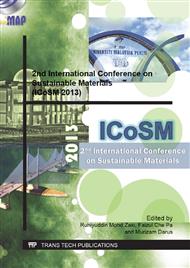[1]
Douglas S. Coombs, Alberto Alberti, Thomas Armbruster, (1997). Recommended nomenclature for zeolite minerals, The Canadian Mineralogist, Vol. 35, pp.1571-1606.
Google Scholar
[2]
Vladimir V. Murashov, Mary Anne White, (2002). Thermal properties of zeolites: effective thermal conductivity of dehydrated powdered zeolite 4A, Materials Chemistry and Physics 75 (2002) 178-180.
DOI: 10.1016/s0254-0584(02)00051-2
Google Scholar
[3]
Amir Charkhi, Mohammad Kazemeini, Seyyed Javad Ahmadi, Hossein Kazemian, in: Fabrication of Granulated NaY Zeolite Nanoparticles Using a New Method and Study the Adsorption Properties, Powder Technology, (2012)
DOI: 10.1016/j.powtec.2012.06.041
Google Scholar
[4]
Amir Charkhi, Hossein kazemian, Mohammad Kazemeini (2010). Optimized experimental design for natural clinoptilolite zeolite ball milling to produce nano powders, Powder Technology 203 (2010) 389-396.
DOI: 10.1016/j.powtec.2010.05.034
Google Scholar
[5]
Kani Akcay, Ahmet Sirkecioglu, Melkon Tatlier, O. Tunc Savasci, Ayse Erdem-Senatalar (2004). Wet ball milling of zeolite HY, Powder Technology 142 (2004) 121 – 128.
DOI: 10.1016/j.powtec.2004.03.012
Google Scholar
[6]
O. Caglar Duvarci, Y. Akdeniz, F. Ozmihchi, S. Ulku, D. Balkose, M. Ciftcioglu, in: Thermal behaviour of a zeolitic tuff, Ceramics International 33 (2007) 795 – 801.
DOI: 10.1016/j.ceramint.2006.01.003
Google Scholar
[7]
Fadda, S., Cincotti, A., Concas, A., Pisu, M. and Cao, G. (2009). Powder Technology. 194 (3): 207-216 (2009).
DOI: 10.1016/j.powtec.2009.04.009
Google Scholar
[8]
Chunlong Kong, Toshinori Tsuru (2010). Zeolite nanocrystas prepared from zeolite microparticles by a centrifugation – assisted grinding method, Chemical Engineering and Processing 49 (2010) 809 – 814.
DOI: 10.1016/j.cep.2010.07.005
Google Scholar
[9]
O. Korkuna, R. Leboda, J. Skubiszewska – Zieba, T. Vrubles'ka, V. M. Gun'ko, J. Ryczkowski, (2006). Structural and physicochemical properties of natural zeolites: clinoptilolite and mordenite, Microporous and Mesoporous Materials 87 (2006) 243 – 254.
DOI: 10.1016/j.micromeso.2005.08.002
Google Scholar
[10]
M. Rivera – Garza, M. T. Olguin, I. Garcia – Sosa, D. Alcantara, G. Rodriguez – Fuentes (2000). Microporous Mesoporous Material 39 (2000) 431.
Google Scholar


